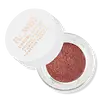What's inside
What's inside
 Key Ingredients
Key Ingredients

 Benefits
Benefits

 Concerns
Concerns

 Ingredients Side-by-side
Ingredients Side-by-side

Mica
Cosmetic ColorantCyclopentasiloxane
EmollientCalcium Aluminum Borosilicate
Diisostearyl Malate
EmollientTrimethylsiloxysilicate
EmollientSilica
AbrasiveIsododecane
EmollientDimethicone Crosspolymer
Emulsion StabilisingSynthetic Fluorphlogopite
Pentylene Glycol
Skin ConditioningPhenoxyethanol
PreservativeTin Oxide
AbrasiveMethicone
EmollientDimethicone
EmollientEthylhexylglycerin
Skin ConditioningCaprylyl Glycol
Emollient1,2-Hexanediol
Skin ConditioningPropanediol
SolventIllicium Verum Fruit Extract
PerfumingCI 77891
Cosmetic ColorantIron Oxides
CI 77510
Cosmetic ColorantMica, Cyclopentasiloxane, Calcium Aluminum Borosilicate, Diisostearyl Malate, Trimethylsiloxysilicate, Silica, Isododecane, Dimethicone Crosspolymer, Synthetic Fluorphlogopite, Pentylene Glycol, Phenoxyethanol, Tin Oxide, Methicone, Dimethicone, Ethylhexylglycerin, Caprylyl Glycol, 1,2-Hexanediol, Propanediol, Illicium Verum Fruit Extract, CI 77891, Iron Oxides, CI 77510
Water
Skin ConditioningMica
Cosmetic ColorantPropanediol
SolventCaprylic/Capric Triglyceride
MaskingPolyglyceryl-4 Caprate
EmulsifyingSilica
AbrasiveGlycerin
HumectantSodium Dehydroacetate
PreservativeAminomethyl Propanediol
BufferingCaprylyl Glycol
EmollientEthylhexylglycerin
Skin ConditioningTin Oxide
AbrasiveChenopodium Quinoa Seed Extract
Skin ConditioningCamellia Sinensis Leaf Extract
AntimicrobialSodium Benzoate
MaskingPotassium Sorbate
PreservativeCI 77491
Cosmetic ColorantCI 77891
Cosmetic ColorantWater, Mica, Propanediol, Caprylic/Capric Triglyceride, Polyglyceryl-4 Caprate, Silica, Glycerin, Sodium Dehydroacetate, Aminomethyl Propanediol, Caprylyl Glycol, Ethylhexylglycerin, Tin Oxide, Chenopodium Quinoa Seed Extract, Camellia Sinensis Leaf Extract, Sodium Benzoate, Potassium Sorbate, CI 77491, CI 77891
Ingredients Explained
These ingredients are found in both products.
Ingredients higher up in an ingredient list are typically present in a larger amount.
Caprylyl Glycol is a humectant and emollient, meaning it attracts and preserves moisture.
It is a common ingredient in many products, especially those designed to hydrate skin. The primary benefits are retaining moisture, skin softening, and promoting a healthy skin barrier.
Though Caprylyl Glycol is an alcohol derived from fatty acids, it is not the kind that can dry out skin.
This ingredient is also used as a preservative to extend the life of products. It has slight antimicrobial properties.
Learn more about Caprylyl GlycolCi 77891 is a white pigment from Titanium dioxide. It is naturally found in minerals such as rutile and ilmenite.
It's main function is to add a white color to cosmetics. It can also be mixed with other colors to create different shades.
Ci 77891 is commonly found in sunscreens due to its ability to block UV rays.
Learn more about CI 77891Ethylhexylglycerin (we can't pronounce this either) is commonly used as a preservative and skin softener. It is derived from glyceryl.
You might see Ethylhexylglycerin often paired with other preservatives such as phenoxyethanol. Ethylhexylglycerin has been found to increase the effectiveness of these other preservatives.
Mica is a naturally occurring mineral used to add shimmer and color in cosmetics. It can also help improve the texture of a product or give it an opaque, white/silver color.
Serecite is the name for very fine but ragged grains of mica.
This ingredient is often coated with metal oxides like titanium dioxide. Trace amounts of heavy metals may be found in mica, but these metals are not harmful in our personal products.
Mica has been used since prehistoric times throughout the world. Ancient Egyptian, Indian, Greek, Roman, Aztec, and Chinese civilizations have used mica.
Learn more about MicaPropanediol is an all-star ingredient. It softens, hydrates, and smooths the skin.
It’s often used to:
Propanediol is not likely to cause sensitivity and considered safe to use. It is derived from corn or petroleum with a clear color and no scent.
Learn more about PropanediolSilica, also known as silicon dioxide, is a naturally occurring mineral. It is used as a fine, spherical, and porous powder in cosmetics.
Though it has exfoliant properties, the function of silica varies depending on the product.
The unique structure of silica enhances the spreadability and adds smoothness, making it a great texture enhancer.
It is also used as an active carrier, emulsifier, and mattifier due to its ability to absorb excess oil.
In some products, tiny microneedles called spicules are made from silica or hydrolyzed sponge. When you rub them in, they lightly polish away dead skin layers and enhance the penetration of active ingredients.
Learn more about SilicaTin Oxide is an inorganic oxide used to add opacity and volume to a product. In nature, it is already found in mineral form. The main ore of tin is an opaque and shiny mineral called casseterite.
Tin Oxide helps remove translucency in a product, or make it more opaque. Besides adding opacity, tin oxide is used for bulking to add volume.